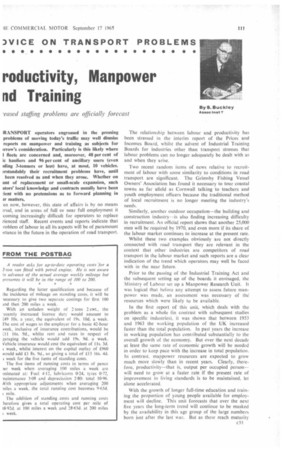FROM THE POSTBAG
Page 111

If you've noticed an error in this article please click here to report it so we can fix it.
A reader asks for up-to-date operating costs 'for a 2-ton van fitted with petrol engine. He is not aware advance of the actual average weekly mileage but presumes it will be in the range of 100 to 200.
Regarding the latter qualification and because of he incidence of mileage on standing costs, it will be lecessary to give two separate costings for first 100 And then 200 miles a week.
With an unladen weight of 2 tons 2 cwt., the -ecently increased licence duty would amount to 49 10s. a year, the equivalent of 19s. 10d. a week. De cost of wages to the employer for a basic 42-hour week, inclusive of insurance contributions, would be 0.1 16s. 9d., whilst rent and rates in respect of garaging the vehicle would add 19s. 9d. a week. Vehicle insurance would cost the equivalent of I Is. 3d. t week, whilst interest on the capital outlay of £960 would add £1 8s. 9d., so giving a total of £15 16s. 4d. A week for the five items of standing costs.
The five items of running costs in terms of pence )er week when averaging 100 miles a week arc !stimated at: Fuel 4.12, lubricants 0-24, tyres 072, naintenance 3-08 and depreciation 2-80: total 1096. With appropriate adjustments when averaging 200 idles a week, the total running cost becomes 965d, t mile.
The addition of standing .costs and running costs herefore gives a total operating cost per mile of 18.92d. at 100 miles a week and 28:63d. at 200 miles week.




















































































































































































